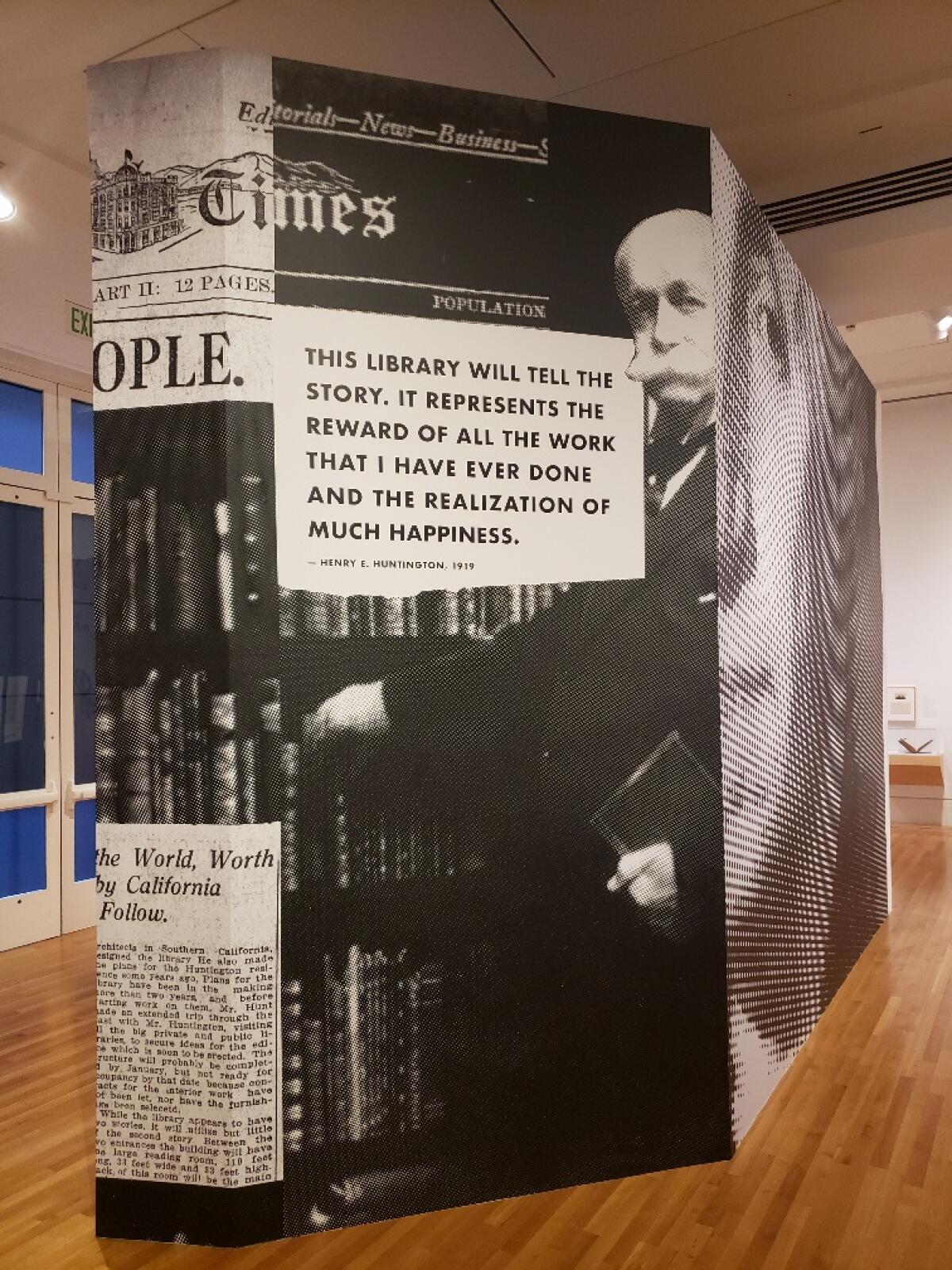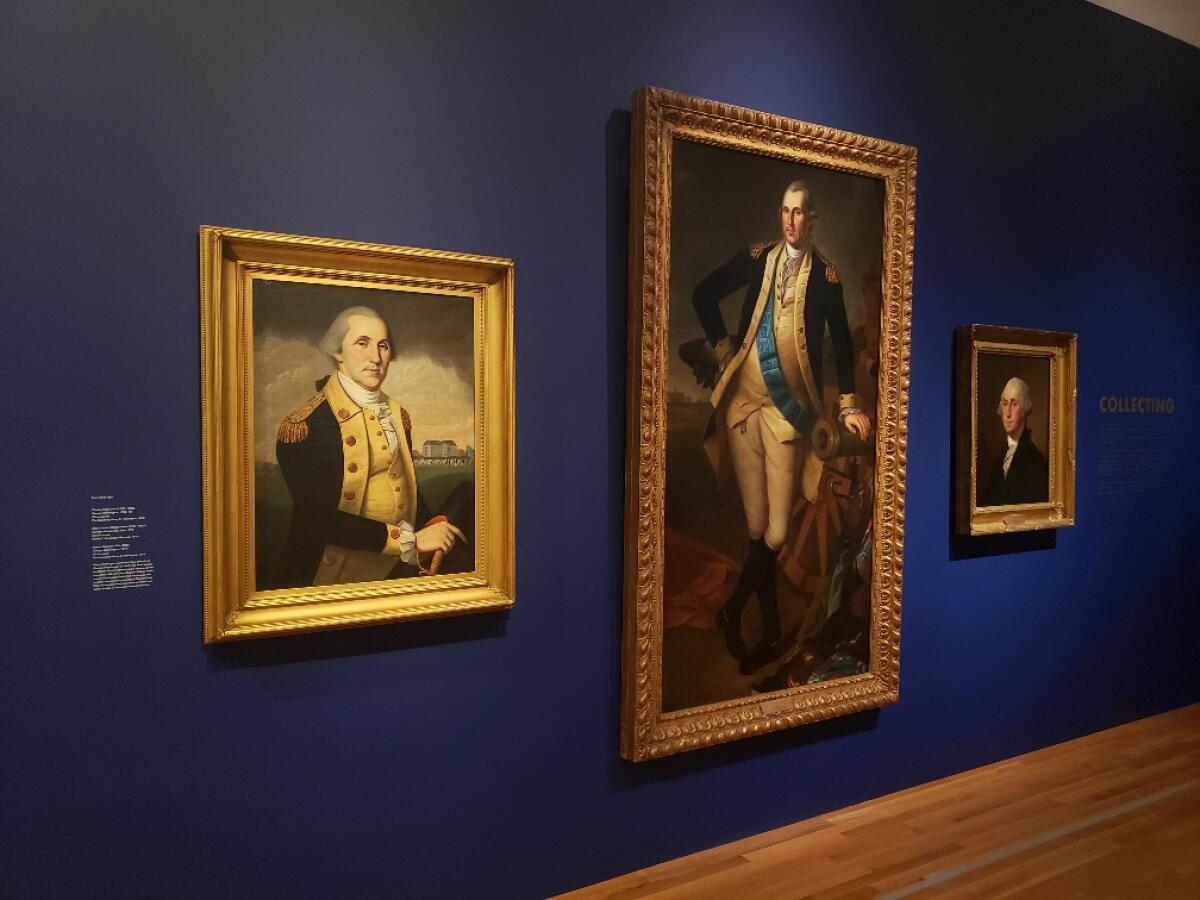‘Nineteen Nineteen’ isn’t what it used to be
- Share via
When Henry and Arabella Huntington gave their massive San Marino estate to the public in August 1919, they had a plan. The two Gilded Age swells, firmly installed near the top among America’s richest people, specified that admission to visit their collections of art, books and botanical specimens would be free.
The stated goal, grandly echoing the Preamble to the U.S. Constitution, was “to promote the general welfare.”
A century later, the Huntington Library, Art Museum, and Botanical Gardens still ranks as one of the more astounding cultural institutions in Los Angeles — rich in British and American literature and art, housed in imposing buildings and set amid 120 acres of extraordinary gardens. Yet even with a $450-million endowment, free it is not.
The Huntington is instead just about the most expensive ticket to a cultural institution in Los Angeles. You won’t learn how that striking change happened in “Nineteen Nineteen,” the museum’s otherwise fascinating new exhibition celebrating its centennial year. But happen it did.
Today, if a couple and their two school-age kids want to see that absorbing exhibition some Sunday afternoon, they’d better be prepared to shell out between $84 and $106 to get in the door. That’s a long way from “a free public library, art gallery, museum and park,” as the founders’ original trust document so nobly announced.

“Nineteen Nineteen” takes its title from a John Dos Passos novel. Dos Passos isn’t much remembered today, but many critics regard the book as one of the 20th century’s most adventurous English-language novels.
Written in 1932 as the specter of fascism was rising in Europe and the global Great Depression was skittering toward rock bottom, it’s a work of nonlinear fiction focused on the stupefied aftermath of World War I. An experimental technique melds news reports, storytelling, graphic art, stream of consciousness and other surprising devices that mull the repercussions of an epic tragedy — 16 million died — in which the writer had seen grueling duty as an ambulance driver.
“The war was a blast that blew out all the Diogenes lanterns,” Dos Passos wrote.
That bleak quote greets visitors to the show in a scene-setting wall text. It signaled the deception and dishonesty that would spawn the madness of the Roaring ’20s and by the decade’s close, the brutal economic collapse of a rampaging industrial world.
By today’s standards, Henry and Arabella were virtual billionaires in 1919. Their $69-million net worth is the equivalent, when adjusted for a century’s inflation, of $1.02 billion today. Their affluence came from several sources.
Inheritance was one. Henry’s uncle, Collis P. Huntington, was born dirt poor, but as a rapacious founding partner and then cutthroat president of the Central Pacific Railroad, he became immensely rich. When Arabella became his widow and married his nephew, Henry, much of his giant fortune remained intact.
Henry is often wistfully cited for building the far-flung, long-since dismantled trolley system that once crisscrossed the vast reaches of Los Angeles. The exhibition features a remarkable hand-drawn map, 39 feet long and apparently being publicly shown for the first time, that charts the sprawling routes of the Pacific Electric Railway.
It also shows adjacent real-estate parcels, carefully annotated, that were the actual point of the mass-transit exercise. Jennifer Watts, co-curator of the show (with James Glisson), describes the vast streetcar system as a loss leader: Huntington made no profit building the Red and Yellow Cars, but the bigger, frankly predatory plan was to conveniently transport people to all that juicy real estate he had for sale from downtown L.A. west to the Pacific Ocean and east to Riverside.
Huntington also built ships. His uncle developed the Newport News Shipbuilding and Drydock Co. in Virginia. By chance, the company’s president went down with the Lusitania, a seagoing disaster that contributed mightily to America’s entrance into World War I. The conflict didn’t hurt a shipbuilder’s bottom line.
“Nineteen Nineteen” displays a wide-ranging cross section of items related to the title’s year, with around 275 chosen from the roughly 11 million in the Huntington’s collections. Virtually everything in it was made, published, edited, exhibited or acquired in 1919.

So, no iconic Gainsborough “Blue Boy” (don’t worry, it’s in another room), but many rarely seen posters, photographs, manuscripts, botanical specimens pressed into books, a few minor Modern paintings, news clippings, a smashing Abraham Walkowitz Cubist drawing of a cityscape seemingly in the midst of a nervous breakdown and more. The inevitably chaotic jumble is given some shape by five loosely thematic sections.
“Fight” looks at the brutal war. “Return” regards the exhausted relief and rising social tensions in its immediate aftermath. “Map” charts the L.A. region, including a visionary fantasy of a massive, never-built cultural edifice planned for the center of the city. “Move” reverberates against a mogul rich from those railroad-streetcar-shipbuilding industries, pulling back to regard a nation on the move.
Finally, “Build” conjures the intersection of the mogul’s private estate with the public institution he put on the drawing board.
“As part of an extensive peace-time programme,” The Times reported on June 27, 1918, “Mr. Huntington commissioned Myron Hunt, an architect, to prepare plans for a library building [for] one of the world’s most valuable libraries.” Hunt’s 1919 ink-on-linen presentation drawing of the planned Neoclassical edifice, floating in ethereal clouds of leafy trees, pretty much describes what took shape in steel and concrete the following year.

Yet, the show is less about the Huntington itself than about the social and cultural context that helped shape it. One of the most absorbing moments is a lineup of three portraits of George Washington, all acquired in 1919, including a dollar-bill classic by Gilbert Stuart. They hang next to a vitrine featuring significant books that arrived by the trainload in San Marino that year.
Among them are autograph memoirs by Benjamin Franklin, Aaron Burr and William Tecumseh Sherman. Huntington had hoovered-up huge and coveted Anglo-American libraries (almost a quarter-million rare and indispensable volumes) during shopping sprees in the East. He was apparently asserting that the colonizing doctrine of Manifest Destiny, however bitterly contested, meant that Los Angeles, where the books and Founding Father paintings would be forever enshrined, was every bit as American as Philadelphia, New York, Atlanta or D.C.
Which brings us to the trust’s original arrangement for a “free public library, art gallery, museum and park.” The pledge came in wake of something else brought about by the end of World War I: Enormous pressure mounted to lighten the tax load of America’s super rich.
The exhibition doesn’t mention it, but the individual income tax was still new. The 16th Amendment was ratified only in 1913, and it was mostly Gilded Age progeny like the “billionaire” Huntingtons who felt the pinch. Joseph J. Thorndike of the Tax History Project once said that without the war, expensive in treasure as well as blood, two charitable tax breaks common today were unlikely ever to have happened.
A deduction for charitable donations was introduced in 1917. When the war ended the following year, a second deduction was added, specifically to reduce estate taxes for bequests. Six months later, Henry and Arabella made their massive charitable donation.
Long after both benefactors were buried on the Huntington mansion’s lawn, public admission to the spoils of their sprawling estate was free. And so it remained until 1996, after a decade in which voluntary, pay-what-you-wish contributions were requested. Huntington leadership then successfully applied to the state’s attorney general to inaugurate an admission charge.
It was set at $7.50.
That number, adjusted for inflation to about $12.50 now, is roughly half the regular adult admission required today. The Huntington has doubled its cost of entry, but other L.A. art museums — the Getty, the Hammer, the Broad — are free, and the Museum of Contemporary Art will soon be too. The San Marino powerhouse remains an exceptional cultural asset for those who can afford to visit it. For those who can’t, “Nineteen Nineteen” celebrates a distant memory.
'Nineteen Nineteen'
Where: The Huntington Library, Art Museum, and Botanical Gardens, 1151 Oxford Road, San Marino
When: Through Jan. 20. Closed Tuesdays
Info: (626) 405-2100, www.huntington.org
More to Read
The biggest entertainment stories
Get our big stories about Hollywood, film, television, music, arts, culture and more right in your inbox as soon as they publish.
You may occasionally receive promotional content from the Los Angeles Times.











